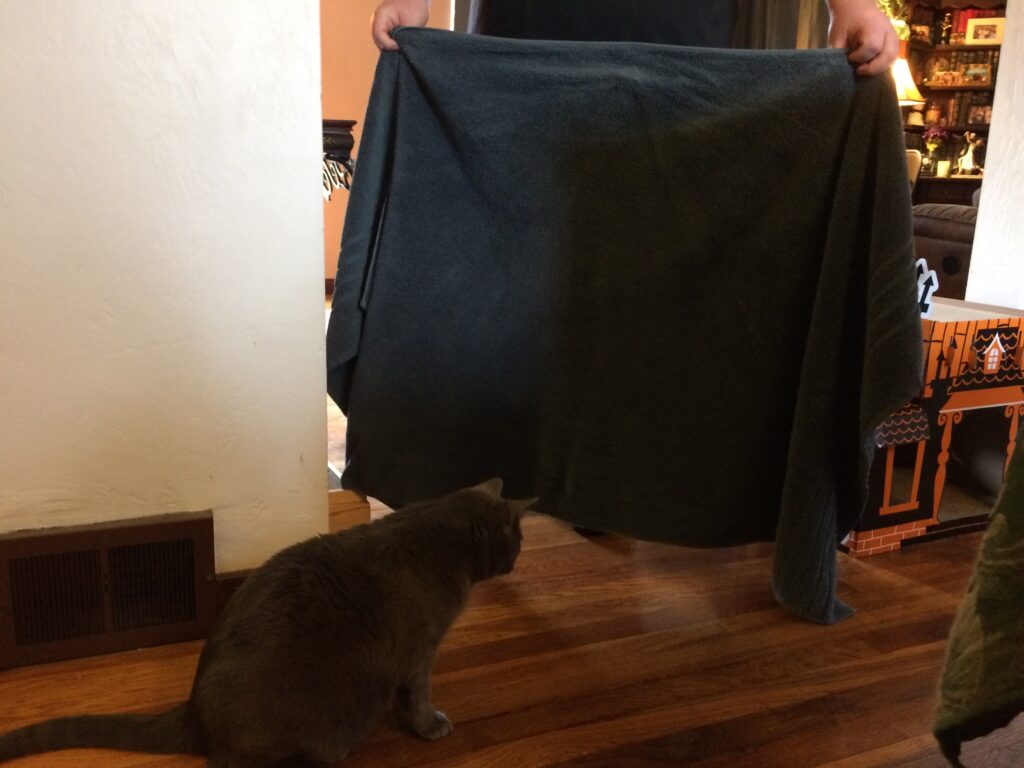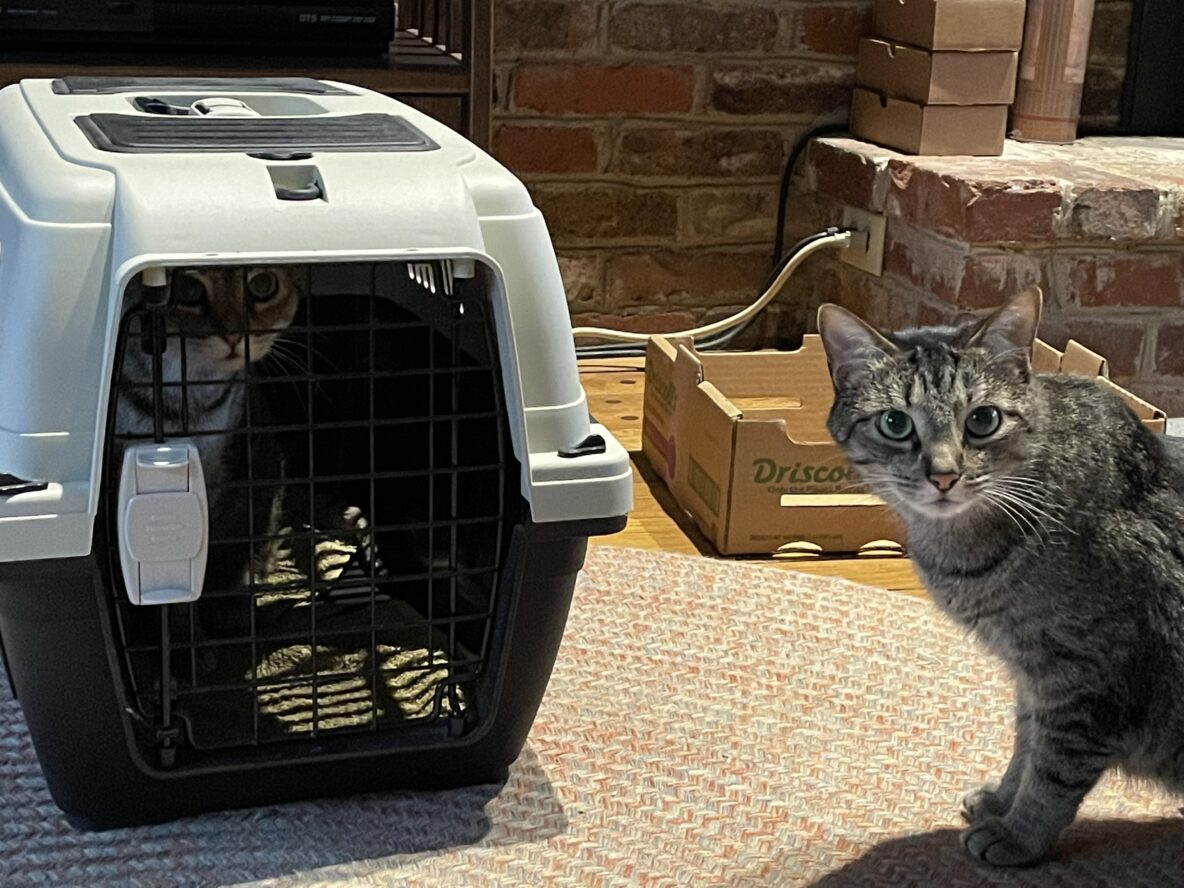What is non-recognition aggression?
People recognize each other by sight. Cats rely more on smell. Each group of cats has a group-scent. If one cat goes somewhere and returns smelling as if he is from another group, he very well may be attacked when he comes home. He may also be attacked if he smells afraid or sick. This is called non-recognition aggression. His friend does not recognize him. Or he does, and is afraid of his fear or illness. His friend is frightened, and attacks to defend himself when this “stranger” or “unsafe cat” approaches. And, yes, it can even happen between cats that have been life-long friends.
How does this happen?
It often happens when one cat goes to the veterinarian. Just as a toddler may be frightened when his big brother walks in the door wearing a scary mask, a cat may be afraid of the scary smell of the veterinarian’s office. His friend smells like a stranger, but is coming right in the door! Right into his home! Well-meaning strangers do not do that, so this is frightening. The cat feels the need to defend himself.
Non-recognition aggression can also happen if that cat had gone to another house. And in the case of indoor cats, if one cat gets outside and then is found and returned, his housemate may attack him. In all of these cases, the cat is not recognized due to the scary smell he has acquired.
How do you prevent it?
If one cat has been out of the home for any reason, please keep him separated from the other cats for a couple of hours. This allows him to lose the smell of the foreign place and start smelling like home again. If the returning cat is sick, it is best to keep him separated until he is feeling better. Cats can smell differently when they are ill. And when you do reunite these friends, monitor them closely. Have a large towel handy to separate them should there be any tension. If a cat is staring, tense, or lashing his tail, separate them. Don’t wait for non-recognition aggression to occur before doing so. And do not punish either cat, or show fear or anger. Be matter-of-fact.

What if there was an attack?
If there was any non-recognition aggression, the cats will have to be kept separated and slowly reintroduced. You can learn about introductions in my blog about this. And you may want to schedule a consultation to ensure it goes smoothy. Undoing incorrect introductions is a long, tedious process.
Patience Fisher owns Patience for Cats LLC, a cat behavior business based in Pittsburgh, PA. She is Associate Certified by the International Association of Animal Behavior Consultants. She holds a Bachelor’s in Biology, a Diploma of Feline Behavior Science Technology, and is a certified veterinary assistant. Check out her humorous YouTube video at her Patience for Cats channel. Visit her on Facebook at Patience for Cats.


Comments 20
Hello there
I have 6 kittens (littermates)
I have 4 male kittens they will be going to get neutered
should I take all 4 to get fixed to avoid non recognition aggression ? I am worried due to recently taking 2 females and the males want nothing to do with them
thank you in advance any advice you can pass forward
Author
Either way, be prepared to slowly re-introduce them after they recover from surgery. My blog on cat intros might help with that. https://patienceforcats.com/introducing-two-cats/ Since they know your house, you’d be on the step of letting them see each other through toddler gates.
Our house is open plan. How can I successfully separate our 2 brothers as one has started attacking his brother and sniffs him alot
Author
You would need to close a cat in a bedroom, and have the cats take turns at large. Be sure they don’t see each other when you swap out!
I recently brought in a cat tree and it was unfortunately infested with fleas (didnt cross our minds to check) and of course my cats were rolling around on it and sleeping in it so i had to bathe them separately. Long since the shower (which was a few days ago) my cat has started hissing aggressively to my other cat (who are both females) but it seems that the other cat still recognizes my cat, my cat has started hitting the other cat. Any suggestions? And maybe something i should mention is that they share one litter box.
Author
I would separate them, or at the very least arrange resources such as litter boxes (you need at least two), food, water, toys, scratch post, etc. so that the cats need not cross paths to access theirs. For instance, you can have resources on each floor of a two-story house. Then you should book a consultation so we can come up with a customized reintroduction. Here is the link to my intake from. https://form.jotform.com/onebarnowl/cat-client-history
I took my male cat to get neutered and female started attacking him. They have been separated for a week now but when I try to reintroduce she starts attacking. Not sure what to do or if it’s just a matter of time. We swap rooms and do feedings at the door.
Author
You need to reintroduce them following the steps in https://patienceforcats.com/introducing-two-cats/
I do NOT recommend feedings at the door! That can make things worse, as the cat is forced to eat next to a cat that upsets him. Most people find a consultation useful, so I can help you take specific steps based on your cats’ body language during the first incremental exposure. All too often people make things worse doing the reintroduction on their own. You can request a consultation using the link to my intake form. https://form.jotform.com/onebarnowl/cat-client-history
I had this issue with my male cat when he had a urinary issue and was in the hospital for a few days. My cats are 3 years old and from the same litter and bonded. I was shocked when I brought male cat home female starting attacking him. Comments above worked for me,.. keeping them separated but I used baby gate so they could see and smell one another. I also bathed my sick cat with baby shampoo. I would also put them in same room and sit between them and give them both anttention/affection and play with them to reassure niether was a threat. It took about 3 weeks to get them back together.
Author
I’m glad you were able to reintroduce your cats successfully! But in general, bathing the cat is not recommended. That will create a strange smell as well, and might even frighten a cat. Smelling fear can cause an attack. As can smelling illness. And shampooing won’t get rid of those smells since they originate from within. I’m glad the shampooing didn’t cause any troubles for your cats. And I’m glad you took your time with the re-intro — well done!
One of my cats has had multiple surgeries, most recent being 48hrs ago. Each time we do a vet visit, we take both cats with us. Obviously the healthy one doesn’t stay at the vet, but does the trip there, gets out in the office and trip home. We thought this would help with the smells and up to now it always has.
It hasn’t worked this time, and I now have one poorly cat desperate for her friend, and another cat who is hissing and hiding from her.
I can’t work out what went wrong this time, but any ideas on fixing it?
They seem to have taken up residence in different bedrooms, but are both rather miserable
Author
You need to reintroduce them. I recommend scheduling a consultation with me so you have a customized plan.
Vet smells aren’t the only cause of so-called non-recognition aggression. There is also the smell of sickness or fear, and visual signs of both as well.
The vet came to my house to give all 3 their shots. Now my 2 male cats are yowling and trying to kill each other. The female is hissing at her littermate but not the other. I’m keeping them separate but they never left the house and shouldn’t smell different. What could it be?
Author
It could be that they saw and/or smelled fear. Once they are calm, you should re-introduce them per my blog https://patienceforcats.com/introducing-two-cats/
I have 2 male cats, one is neutered and the other one is not, they have been living together for about 3 years now without any issues, the one cat keeps on attacking the other cat as if they dont recognise each other, they are fighting aggressively for no reason and neither of them were taken out of the home. The one male cat catched a mouse one day and when the other cat tried to play with it the cat growled at him and ever since then they constantly fight, please can you give me some advise.
Author
Re-directed aggression can also get friends to turn on each other. An example is two friends sitting side-by-side at the window, and then an outdoor cat walks by. One cat feels aggressive towards the stranger, who is out of reach, so attacks his friend. Likewise, the mouse could have frustrated a cat. Regardless, your cats need to be separated and re-introduced. This process would be easier if they were both neutered.
Re-introductions can be complicated. You may want to schedule a consultation with me, after filling out an intake form https://form.jotform.com/onebarnowl/cat-client-history.
This recently happened to our two cats, who are brother and sister. But neither of them have been to the vets.
The first time it happened we think the boy (who is a nutcase) got tangled in a shopping bag and ran off upstairs terrified after freeing himself (never happened before but we are even more careful with the bags now). His sister was hissing at him and following him around sniffing his bum.
That was weeks ago. Since then it has happened a couple more times, though not as bad. She follows him around staring at him, hissing and growling at him without any apparent cause. Sometimes she sniffs his butt vigorously!
They normally get along perfectly, what the heck is going on here?
Side note, I have found a foul smelling patch on the rug recently. It kinda smelled like the worst sweaty feet, mixed with rancid grease and poop smell, but there were no obvious marks? Is this anal gland fluid?
Author
I’m so sorry you are having this problem. It does sound like so-called non-recognition aggression caused by his fearful reaction to the bag. And the other cat is still being affected by that incident. This is too complex to address more fully here. You may want to schedule a consultation with me, after filling out an intake form https://form.jotform.com/onebarnowl/cat-client-history
“An example is two friends sitting side-by-side at the window, and then an outdoor cat walks by. One cat feels aggressive towards the stranger, who is out of reach, so attacks his friend. ” This exact thing happened to my cats last night. A stray cat came up to our window and my male cat reacted and my female cat came up and he attacked her. They had not shown any aggression toward each other before this. We have since separated them and they are both calm at the moment but he still gets “poofy” tail when he sees her and will probably attack if im not there. I am slowly changing them out of the bedroom every hour or so. Do you do remote consultations?
Author
I’m glad you separated them, and are letting them take turns in the house. Yes, I do many remote consultations. Please fill out an intake form for both of your cats. After submitting one form, you can use the back tab to edit for the next cat. If for some reason this doesn’t work, you can type “same” on fields that are the same, but please still put your name and email on the second form. Here is the link https://form.jotform.com/onebarnowl/cat-client-history